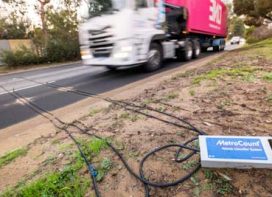 Sudhir Hoshing, CEO – Roads, Reliance Infrastructure Limited tells Vidyottama Sharma that foreign players may not be keen to execute road projects in India on their own as the challenges of on-the-ground implementation are difficult to surmount for them.
Sudhir Hoshing, CEO – Roads, Reliance Infrastructure Limited tells Vidyottama Sharma that foreign players may not be keen to execute road projects in India on their own as the challenges of on-the-ground implementation are difficult to surmount for them.
Many infrastructure companies now are globally known for their apt implementation of projects – in India and abroad. But where do we stand when it comes to the knowledge transfer from the foreign companies to which work is outsourced, especially in road infrastructure?
 Although we keep abreast of the global technology as it evolves in road construction and traffic management, we as a roads business haven’t really worked with foreign partners except some usage of latest machineries and some ground, soil and bitumen improvement technologies. It must be noted that though there appear to be a lot of foreign players interested in the sector, many of these players may be used by local businesses/small players to qualify for bidding.
Although we keep abreast of the global technology as it evolves in road construction and traffic management, we as a roads business haven’t really worked with foreign partners except some usage of latest machineries and some ground, soil and bitumen improvement technologies. It must be noted that though there appear to be a lot of foreign players interested in the sector, many of these players may be used by local businesses/small players to qualify for bidding.
Hence, there may not really be an actual knowledge transfer. Foreign players may not be keen to execute projects on their own as on the ground, implementation challenges are difficult to surmount for them. In the roads sector, work is predominantly being done by Indian companies – some are big national players while others are local contractors.
Has India made sufficient progress in road infrastructure in the last seven to eight years?
The introduction of Private Public Partnership (PPP) in roads a decade ago has enabled progress in the sector. PPP has brought in the required capital & efficiency to overcome the capital crunch which the government was facing initially and expedite the implementation of the projects respectively. According to a study conducted by IIT Madras, the unit cost of private sector project was 40.2 as compared to 45.07 of a public funded project.
The length of roads constructed by National Highways Authority of India (NHAI) has increased to 30,412km till FY10 from 3,778 km in FY05. In 2009-10, 5010km of roads were constructed at the rate of 13.81 km/day.
Domestic banks and institutions have shown considerable capacity to fund such large scale road development projects in the country mainly due to the capability of the private players. NHAI, the executing authority too, has evolved over the years and has standardised its bidding practices. It is continuously making its processes transparent – either through e- bidding or via the Electronic Tolling Collection (ETC). ETC would enable toll to be collected electronically from vehicles at toll plazas while the vehicle is in motion.
But there still are challenges in implementation. There is a need to fasten the progress of awarding and procuring approvals and clearances.
Failure of roads occurs mainly due to improper drainage system. Hence, drainage is very important, both in relation to road pavement construction and maintenance. Poor drainage conditions, especially during rainy seasons, force the water to enter the pavement from the side as well as from the top surface. In case of open graded bituminous layer, this phenomenon becomes more dangerous and the top layer gets detached from the lower layers.
What challenges do infrastructure companies engaged in road construction and facilities face while implementing projects in India?
One of the major challenges in implementing projects is Land Acquisition. The non-availability of land delays the project resulting in cost overrun thereby rendering a project unviable. Recently, a one off case of cancellation of IRB’s Goa Project was due to the unavailability of land. Though the concerned authority provides us land free from encumbrances, there are illegal encroachments which are difficult to dismantle.
We also face issues of lack of coordination between different government agencies and delay in procuring permits and approvals. For instance, while implementing a road project we need permissions from various agencies – like state forest departments, revenue departments, local panchayats, etc. When we need to shift utilities like pipelines and phone lines – permission from multiple agencies has to be sought again. This restricts timely completion of the project.
Among other challenges are lack of good contractors and skilled technical manpower. As far as financing a project is concerned, the cost of funds is rising and raising cheaper ECB loans is also difficult. The Government has to step in and create long term cheap sources of financing. The ‘tax free bonds’ is one such initiative in the right direction.
What latest technologies have entered the country on road infrastructure? Are they sufficient to meet today’s challenges? Does customisation of technology create a problem?
The ambitious target for the rapid improvement of India’s road infrastructure includes the development and incorporation of new technologies and construction methods. One of the methods currently being pioneered involves the incorporation of recycled plastic blended with the bitumen. Tests have found that mixing the plastic, mainly polyethylene, with the bitumen can have positive effect on the durability of the road surface. There are new machineries being used like advanced pavers, Geo Grid membranes, etc. Our designs in India are of international standards.
However, road technology is still not highly evolved in India. For instance, we don’t still use recycled aggregate material in India. Developed countries, even China, have the practice of not quarrying for fresh material but using recycled material to build roads.
There are other technology improvements that are possible. However, consultants who oversee our execution on behalf of the government authorities are not comfortable in embracing the new technology.
How sympathetic or otherwise are Indian laws and administration (including Union and state governments) to the companies providing infrastructure for the roads?
Though the Indian laws are in place to ensure that the concern of every stakeholder is given due consideration, the delays are on account of approvals pending with the government agencies. This is on account of lack of coordination between the agencies. The mandate given to all these agencies should ensure speedy completion of the projects.
Also, in the stages of land acquisition, time limit to complete 3G after 3A is of one year which needs to be reduced. However, there are clauses providing for damages on account of any delay due to government agencies which don’t compensate appropriately.
Why do we nearly always face failure in road technology/maintenance with the entire system going haywire in monsoon? What are the remedies?
I would stress here that most of the roads which are being developed under NHDP scheme do not have such problems.
However, failure of roads occurs mainly due to improper drainage system. Hence, drainage is very important, both in relation to road pavement construction and maintenance. If water can’t find a path out of the road pavement, failure of the highway will be premature and swift, as the wheel load will no longer be correctly transferred downwards through the road pavement to the underlying Subgrade. Poor drainage conditions, especially during rainy seasons, force the water to enter the pavement from the side as well as from the top surface. In case of open graded bituminous layer, this phenomenon becomes more dangerous and the top layer gets detached from the lower layers.
There can be other reasons for distress / failures such as provision of poor clayey subgrade, temperature variation ranging from 50°C to below zero conditions in the plain areas of North and Central India leading to bleeding and cracking, non maintenance of the temperature of bitumen / bituminous mixes, etc.
The remedy for avoiding failures is to provide adequate drainage system (both longitudinal and cross drainage), incorporate good engineering practices, maintain quality standards and take adequate & immediate maintenance measures in case of failures.
 TrafficInfraTech Magazine Linking People Places & Progress
TrafficInfraTech Magazine Linking People Places & Progress


